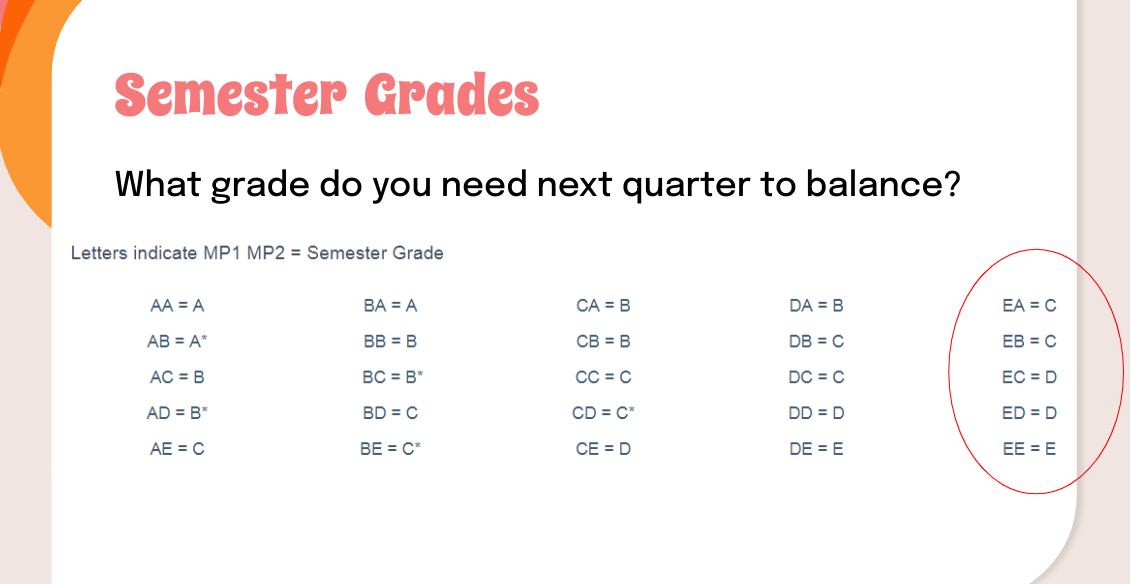There are two types of straight-A students. There are the ones who get an 89.5% one quarter, then a 81% the next quarter to receive a semester A. Then there are those who get a 98% in every class every quarter. How do colleges differentiate those students and how is grade inflation making that harder?
In MCPS’ grading system, a D is passing and a quarter C and quarter E brings you to a semester D. This means that a student could get a C in a class for one quarter, and not show up to school at all for the second half of the semester and still pass the class. This grading policy has lessened the value of high school diplomas because schools are giving students higher grades for the same work. A study that the College Board conducted in 2017 showed that while the GPA average in high schools went up from a 3.27 to a 3.38 from 1998-2016, SAT averages decreased. This implies that the GPA averages of high school students did not increase due to rising student achievement.
Grade inflation has made it easier for a student to get an A, and made it harder to identify an exceptional student from others at their school. Since Montgomery County’s grading system makes a quarter A and quarter B a semester A. Students say this, “gives you a second chance to get a semester A if you got a B for quarter one. I think it could also make [differentiating students] harder, but students also have extracurriculars that can help [colleges] determine who’s a good candidate,” junior Caroline Min said.
While current students and the past generation say that students work harder now to get into college, this is because of growing out-of-school involvement expectations, not necessarily having to work harder to get A’s. Since grading systems have become more lenient, students are able to get A’s without properly gaining the knowledge of the courses they took. This has consequences like making college and careers more difficult. AP Seminar and Research teacher Michelle Hanson said, “I know we are in high school, but we are that step before college and it’s up to us to help you make that transition, but if you can always figure out how to get the grade you want, that’s not helpful.”
Another example of grade inflation is the 50% rule. When MCPS had it, the 50% rule made getting high grades easier for students. What this rule did was ensure that if a student didn’t complete an assignment or assessment, or scored lower than a 50, they were automatically given a 50% on it. This helped students, especially with practice/prep assignments, because if they had a comfortable grade in a class, they tended to become more relaxed toward the end of the quarter. “I am always trying to help students achieve no matter the grading policy. So, honestly, I wish we didn’t have a grading system so we can allow students to focus more on learning and taking more chances without the fear of failure,” English teacher Madeleine Osgood said.
With this current grading system, it is up to teachers to ensure that their students are properly retaining the information they are being taught. “I would love for students to be able to reassess any assignments that they wanted; that is how they learn. However, with so many students in class, this is not always feasible/possible. So, we as teachers are always thinking about ways to help the students grow and achieve by splitting up larger assignments into smaller chunks or offering help during advisory or lunch.” Osgood said.
Grade inflation is increasingly becoming an issue nationally, and in this county. However, some ways to solve this problem is to make teachers hold students accountable for showing proficiency in subjects. Additionally, to fix the difficulty colleges have in differentiating students, they could require students to submit quarter grades as well as their GPA and semester grades. These are just a couple solutions to grade inflation, so my advice to you is: think about how grade inflation affects your education and the way you apply to colleges.






![The 2025-2026 Editorial Board Alex Grainger, Cameron Cowen, Helen Manolis, Emory Scofield, Ahmed Ibrahim, Rebekah Buchman, Marley Hoffman, Hayley Gottesman, Pragna Pothakamuri and Natalie Pak (Chase Dolan not pictured) respond to the new MCPS grading policy. “When something that used to be easy suddenly becomes harder, it can turn [students’] mindset negative, whereas making something easier usually has a better impact. I think that’s where a lot of the pushback comes from. But if you put emotions aside, I do think this change could help build stronger work ethic,” Ibrahim said.](https://woottoncommonsense.com/wp-content/uploads/2025/09/fqr5bskTXpn0LRQMmKErLuNKdQYBlL726cFXBaWF-1200x900.jpg)


